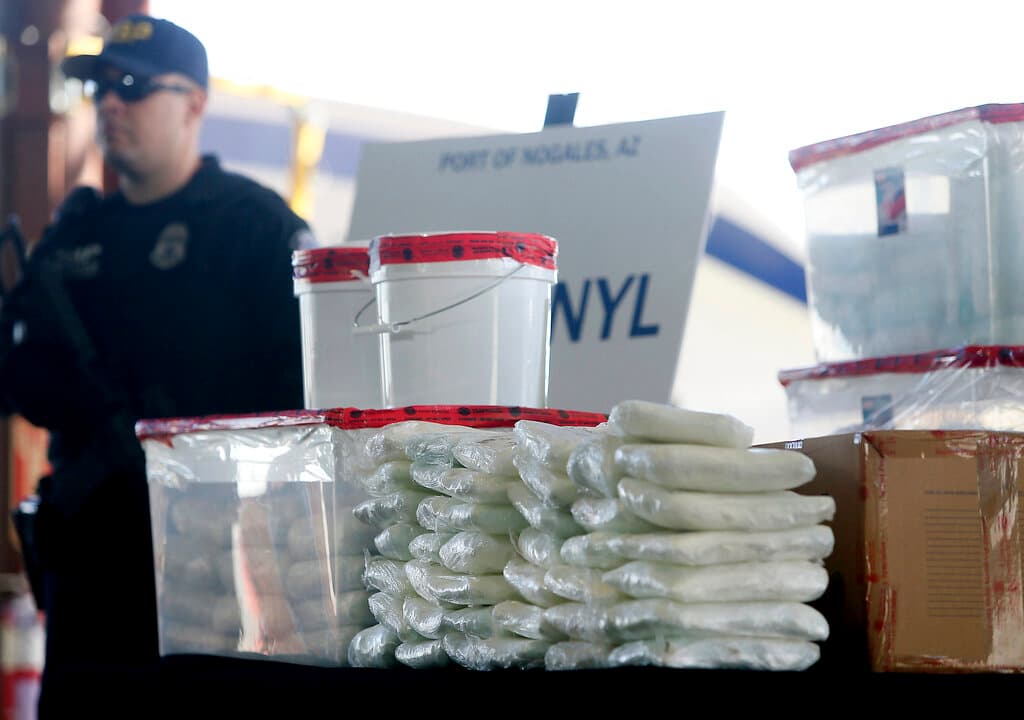‘Stronger Than Walter White’s Meth’ From ‘Breaking Bad’: The Meth Crisis That ‘No One Is Talking About’
It calls for an urgent and direct approach to addressing the ‘narcoterrorist threat that the cartels now represent,’ a retired DEA special agent tells the Sun.

While national attention on the drug crisis centers around opioids, an alarming amount of cartel-produced methamphetamine is flooding American illicit drug markets.
Although meth, a powerful and highly addictive stimulant that affects the nervous system, has been around for decades, data from the Centers for Disease Control and Prevention show that meth overdoses, both combined with opioids and without, are on the rise. The crisis is leading to a growing sense of urgency about the need to combat “narcoterrorism” and find bilateral policy solutions with Mexico and Communist China.
“No one is talking about meth,” a clinical psychologist who treats patients at the Philadelphia area, Geri-Lynn Utter, told the Sun, yet it’s “a serious issue that’s been lurking in the shadows, that treatment providers have been dealing with regularly.”
Meth is “as much an issue as xylazine and illicitly manufactured fentanyl,” Ms. Utter said, and while the opioid crisis has been “front and center, meth has been quietly doing a lot of damage across the country.”
As a care provider, she said she has seen a “significant increase” in meth use for at least the past decade, and the meth is so pure and potent that “it’s stronger than Walter White’s meth from ‘Breaking Bad,’” she added, in reference to the award-winning television series.
The high-purity meth causes some users to suffer a “prolonged psychotic state,” she said, and “there are also significant, residual neuropsychological effects seen in people who abuse crystal meth.”
While fentanyl can kill users within minutes, the ill effects of meth usage tend to include long-term health problems, a retired special agent for the Drug Enforcement Administration of 32 years and expert in chemical supply chains for drugs, Michael Brown, told the Sun.
“Nobody’s paying attention, everybody’s focused on fentanyl,” he said. “Meanwhile, methamphetamine trafficking is increasing. All we hear about are fentanyl seizures — we don’t really hear a lot about big methamphetamine seizures, because all resources are focused on fentanyl.”
Putting all the attention on fentanyl is “very dangerous,” he said, “because now we’re allowing methamphetamine usage to basically increase unchecked,” leading to more production and lower prices.
“Now we’re going to be faced with long-term methamphetamine substance addiction, mental illness, and all the other host of issues,” he said, including rotting teeth and gum disease that can lead to brain disease, hepatitis, hallucinations, and organ failure. “It’s a terrible existence for anybody who’s on long-term methamphetamine usage.”
Because not enough people are paying attention to meth and fentanyl has taken center stage, he said, “next thing we know, 10 years from now, we’ll have all these people that suddenly die from methamphetamine.”
The majority of meth in illicit drug markets today isn’t coming from mobile meth cookers, motorcycle gangs, or home labs, but rather from Mexican cartels that source the majority of their precursor chemicals from China. That means the issue is one that can’t only be tackled domestically, Mr. Brown noted.
“I don’t think we can regulate our way out of this,” he said. “This is going to take a more direct approach to mitigating what I call the narcoterrorist threat that the cartels now represent.”
The cartel problem can largely be traced back to the early 2000s, when the federal government cracked down on cold medicines that contained pseudoephedrine — an ingredient that drug groups were using to mass-produce meth — by putting the medicine behind the pharmacy counter. That gave Mexican cartels their “aha moment,” Mr. Brown said, and “overnight, the cartels in Mexico became the no. 1 producers of methamphetamine in the Western Hemisphere.”
That changed the drug dynamic because American law enforcement now has to rely on working with Mexican authorities. “High levels of corruption and other issues have limited the U.S. ability to significantly mitigate the methamphetamine production or the acquisition of those essential chemicals,” Mr. Brown said.
Cartel meth has always had “excellent quality,” he added, and the purity of it indicates that the cartels “have access to some very good, high-quality chemicals.”
Should China, as the “predominant source” of the precursor chemicals, fail to take action in the next couple of months, he said, it’s clear that Beijing is “exercising willful blindness, and allowing criminal cartels to work in conjunction with Mexican groups that flood America with poison.”
“Is this part of China’s 100-year war strategy? If you read the book you may say yes,” he said, adding that addressing the issue requires relying on bilateral relationships. “And if that relationship is not good, as it is in Mexico and China, then we will continue to see narcotics flooding in this country. “
As Customs and Border Protection agents are pulled from border checkpoints to process tens of thousands of migrants, cartels take advantage of border gaps to move more drugs across the border, Mr. Brown said.
Criminal organizations are using a “wide variety of tactics” to move illicit drugs into America, a CBP representative told the Sun. Those shipments can be in personal vehicles, produce shipments, commercial cargo, and more. “Attempting to conceal narcotics within shipments of all kinds is a common tactic encountered by CBP law enforcement personnel.”

